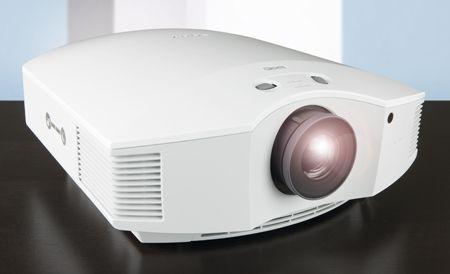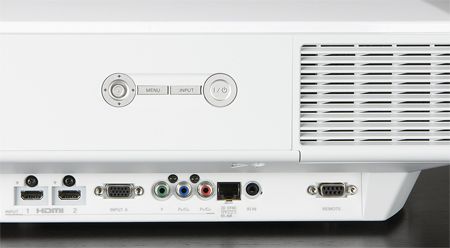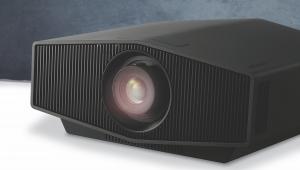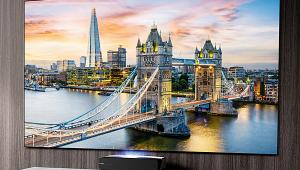Sony VPL-HW55ES review

 In a perfect world we’d all be able to set ourselves up with one of Sony’s ground-breaking VPL-VW500ES 4K projectors. But most of us don’t live in a perfect world, or anything close. Finding the £8,800 necessary for a VPL-VW500ES just isn’t an option.
In a perfect world we’d all be able to set ourselves up with one of Sony’s ground-breaking VPL-VW500ES 4K projectors. But most of us don’t live in a perfect world, or anything close. Finding the £8,800 necessary for a VPL-VW500ES just isn’t an option.
Happily, though, Sony has come up with a pretty excellent ‘consolation prize’ in the shape of the VPL-HW55ES. This projector doesn’t enjoy a 4K resolution, but its Full HD pixel count is backed up by some impressive other specifications, and can be yours for the vastly more attainable sum of £2,800.
You get a lot of projector for your money, too. Its dimensions in each direction exceed those of most sub-£3,000 projectors, and its size is emphasised – though tastefully so – by the way its upper edge arcs up. This bulging mid-section fits over a large centrally-mounted lens, and the whole attractively-sculpted thing comes clad in a nice high-gloss white or black finish.
The VPL-HW55ES’s connections (including twin HDMIs) are side- rather than rear-mounted. This could present some people with minor install issues, but it’s hardly a deal-breaker. An RJ-45 port is there for adding an external 3D transmitter (IR or RF) if your room layout requires one. There’s also an optional wireless HDMI kit.
At the VPL-HW55ES’s heart is Sony’s SXRD projection technology, delivering a promising claimed contrast ratio of 120,000:1 and an equally promising maximum light output of 1,700 Lumens that could prove handy with 3D. The contrast ratio is dependent on a dynamic iris system rather than being a native figure, but this is to be expected (unless you’re a JVC D-ILA model) and doesn’t mean the image can’t still look the business so long as the dynamic iris system is effectively implemented.
As with its predecessor, the VPL-HW50ES, the VPL-HW55ES sports a lamp control system that syncs its output with the machinations of Sony’s active shutter glasses to deliver a brighter, more colourful 3D image. Other notable features include Sony’s Reality Creation image processing for enhanced detail and colours; electronic RGB panel alignment; 11 gamma presets and Sony’s Real Colour Processing suite.
This new model is straightforward to set up. There are tactile vertical and horizontal image shift wheels on top, the zoom ring around the lens delivers a good 1.6x level of optical zoom, and the focus ring permits precise adjustments. Within just moments you’ll be watching focused, accurately sized images with no digital keystone distortions required. And about 30 seconds after that your mouth will likely be hanging open in awe...

Feeding the projector two of the finest-looking Blu-rays known to man, Oblivion and Pacific Rim, it produced pictures so good I had to triple-check the £2,800 price.
Initial impressions are of stunning detail and sharpness. Both discs deliver reference levels of texturing and detail, and every last pixel of that quality appears with the upmost precision via Sony’s affordable light-cannon. In fact, while purists will probably choose not to use the feature, Sony’s Reality Creation system seems to take sharpness beyond vanilla Full HD. The extreme clarity of the hulls of Pacific Rim’s Jaegers is spectacular.
Reality Creation can get messy if you force up its Resolution and Noise Filtering settings, and its effectiveness understandably deteriorates with lower-quality sources. Leave the Resolution and Noise Filtering options set to between 10 and 20, though, and having Reality Creation in play proves worthwhile.
Easier to resist are the VPL-HW55ES’s Motionflow options. Despite some modes being well balanced by the standards of the motion processing world at large, they all still deliver a few unwanted side effects.
The most interesting Motionflow mode is Film Projection, which ‘disguises’ judder by attempting to recreate the slight flickering effect associated with traditional 24p commercial cinema projection. It won’t be to everyone’s tastes, but it’s worth an extended trial – even if at first you don’t like it.
Contributing to the VPL-HW55ES’s good pictures is its dynamism. Pictures are brighter than they were on the VPL-HW50ES, but have been delivered without compromising black level response. On the contrary, black levels are better, and combine with the enhanced brightness to deliver a fabulous contrast range.
JVC’s DLA models can still out-punch the VPL-HW55ES where sheer black level depth is concerned, but that prowess isn’t married to levels of brightness to rival the Sony.
The VPL-HW55ES’s huge visual range has a beneficial effect on its colour reproduction, helping hues explode off the screen. This is particularly obvious with the colour-rich Pacific Rim – particularly the sequences set in the film’s various city locations. The Sony lays on rich saturations, but with subtlety and accuracy. In fact, images using some of the picture presets are startlingly accurate right out of the box, and the colour definition on show with even the trickiest colour blends is ridiculously good for the money.
Usually when testing projectors in a fully blacked-out room I use a projector’s low-output lamp option to boost black levels and reduce running noise. However, the VPL-HW55ES handles its light so intelligently – even if you ignore the dynamic iris feature – and runs so quietly for such a bright machine that I found myself unable to resist the extra punch you get from its brightest lamp setting.
The Sony's 2D heroics aren’t quite replicated with Pacific Rim’s 3D platter. Using the default 3D setting I was still impressed by the brightness and colour saturation, while the PJ's excellent contrast performance delivers a rich sense of depth and space, and detail levels are high. Yet that old active 3D chestnut of crosstalk noise is readily apparent over many sharply contrasting objects, especially if they’re in the background.
Pacific Rim’s near-constant use of bright, colourful lights in its backdrops is certainly not the VPL-HW55ES’s friend. There is, fortunately, a crosstalk fix: reducing the 3D Glasses Brightness option from Max to Min. However, this really hammers the image’s brightness. Many users will thus probably prefer a compromised middle setting – but you’ll still notice some crosstalk in such a configuration.
Despite its slightly compromised 3D pictures, Sony has come up with a marvel in the VPL-HW55ES. Its pictures are more dynamic than those of Panasonic’s now-aging AT6000E and JVC’s DLA-X35, and it’s fair to say it represents a truly Jaeger-scale opponent for Epson’s EH-TW9200 Kaiju. Let battle commence!
Specification
3D: Yes. Active shutter (two pairs of glasses supplied)
Ultra HD: No. 1,920 x 1,080
Connections: 2 x HDMI v1.4; component video input; IR input; RS-232; D-Sub PC port; RJ-45 input (for adding optional external 3D transmission extender)
Brightness (claimed): 1,700 Lumens
Contrast (claimed): 120,000:1
Dimensions: 407.4(w) x 463.9(d) x 179.2(h)mm
Weight: 9.6kg
Features: SXRD projection system; Reality Creation processing; Motionflow processing; optional wireless HDMI kit; Sony’s Real Colour Processing colour management system; multiple themed gamma presets; vertical and horizontal image shift; 1.6x optical zoom; 40-300in screen size support; dynamic iris system; intelligent lamp system for 3D; 3D Glasses brightness adjustment; 21dB claimed fan noise
 |
Home Cinema Choice #351 is on sale now, featuring: Samsung S95D flagship OLED TV; Ascendo loudspeakers; Pioneer VSA-LX805 AV receiver; UST projector roundup; 2024’s summer movies; Conan 4K; and more
|























































